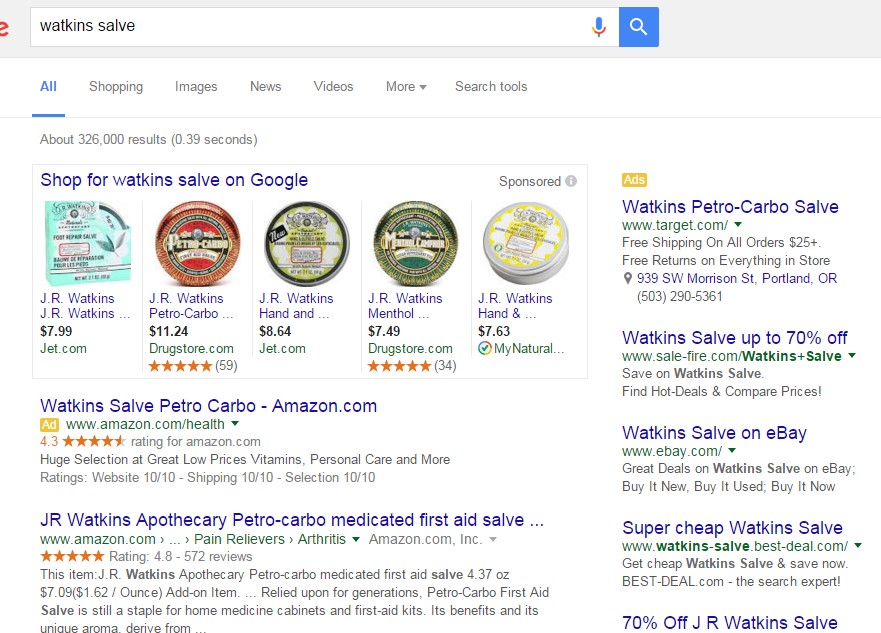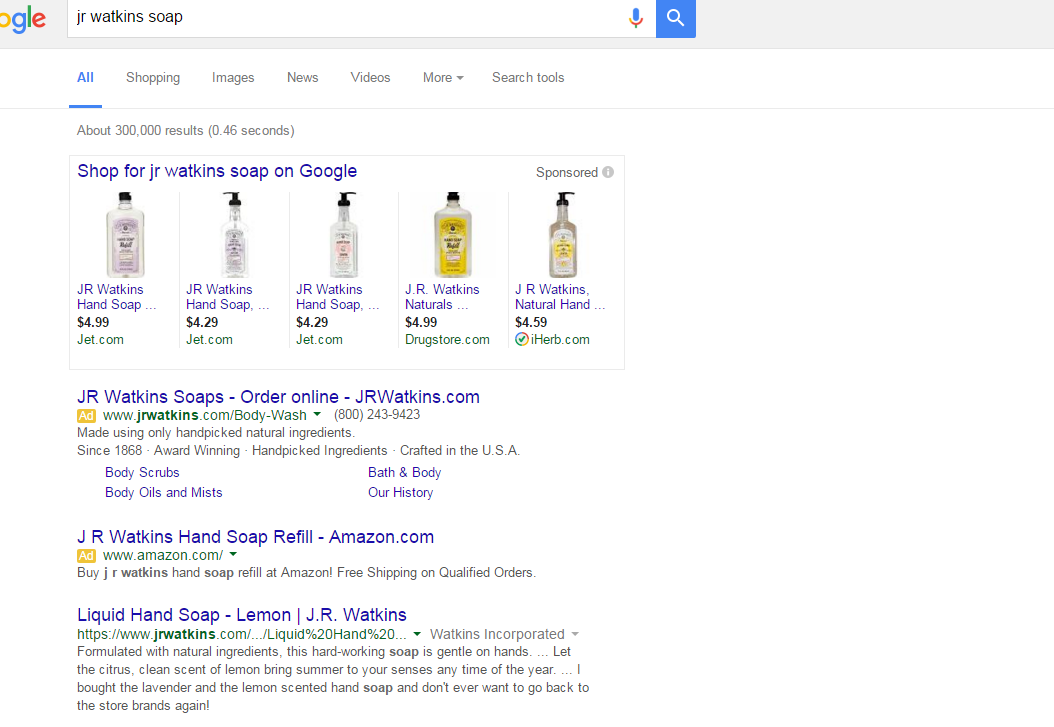Dude, Where’s My Ad?!
by Anvil on February 24, 2016Paid AdvertisingStarting this week, Google AdWords has removed text ads from showing on the right side of Google search engine results pages (SERPs) – one of the biggest format changes for the search channel in a long time. This is causing an uproar across the search landscape for marketers, small businesses, large corporations, and everyone in-between for good reason: this change has a high impact on all channels – particularly PPC campaigns and organic search. However there are many benefits to this change looking into the future, and Anvil is here to guide you along the way!
What’s Happening?
Before this change, Google’s SERPs provided three ad placements at the top and bottom of every page, plus 5-7 ads to the right of the organic results:

The new offering cuts the number of placements in half by doing away with the right column and adding one additional placement at the top of the page:

Currently, Google has announced that product listing ads and ads in the knowledge panel will not be affected by this change; as well as the three ads on the bottom of the SERPs.
Why Are They Doing This?
Google has been testing different formats for SERPs as far back as 2010 for search queries on specific verticals like finance/mortgage, and originally stated that they would only be implementing a change to include 4 top results pages on high-volume, “commercial” searches. In reality, the rollout appears nearly complete as of today for all searches on desktop for all verticals.
As to why Google would do such a thing? While there is no official statement, there are many theories:
- The Media Image thinks it’s a profit move: right-hand sidebar ads have fewer click-throughs and are inflating CPCs for higher-performing top-of-page ad space
- It may be for the benefit of user experience and utility: removing the right-hand sidebar ads allows more space for useful Knowledge Graph and Google Shopping ads for certain searches
- They are streamlining cross-device user experience: by mirroring the mobile experience, Google may be trying to add consistency for design across devices.
Regardless of the reasoning, the change has rolled out completely and Anvil wants to make sure you’re prepared for the implications.
What Does This Mean For You?
With ads being limited to the top four positions, organic results will be pushed further down the page, potentially below the fold, ultimately making paid a bigger player in the game. This will increase the importance for every business that wants to succeed in the ever-growing digital world, to have a slice of their marketing budget allocated to paid search advertising, to maximize real estate on SERPs.
Also with this change, not only will paid search ads become more competitive, but so will Product Listing ads (PLAs or also Google Shopping Ads). Although right-hand sidebar ads have been eliminated, the space is still made available for Google Shopping ads, which place even greater importance on providing optimal coverage on that ad product.
In addition to PLAs, Google also has existing ad products that plug directly into the Knowledge Graph, specific to particular industries that advertisers can also leverage. For brands in the hospitality space, Hotel Price Ads, are one option to ensure coverage on in order to maximize impression reach on SERPs now that the right-hand-sidebar ads are gone.
How Anvil is Adapting
Google’s SERPs change is potentially game-changing, only if your paid search strategy is not already adapting. Here are some tips and tactics that Anvil recommends applying that we are currently implementing with our campaigns that will make sure you still rake in high returns:
Monitor CPC prices: The main fear with this change is that CPCs are going to increase significantly due to less quantity and quality of ad space. This is not necessarily the case: for high-interest, commercial searches there is still sufficient inventory to include more advertisers in top positioning without raising prices. It is still too early to tell what impact the change has on pricing, but Anvil recommends being prepared to either double down on funding or reassess positioning if CPCs rise significantly.
Reassess Ad Positioning Strategy: The majority of campaigns prioritize top positioning to maximize impression reach on paid search but based on goals top positioning might not be worth the cost. Anvil recommends measuring against CPA and ROAS goals for top of page versus below to see whether it is worth the cost to show at position 1. Often times we will see high volume at higher positions, but more profitability in lower spots.
Optimize Ad Copy and Extensions: With all ads relegated to the main SERPs column, this places even more importance on maximizing the use of and optimizing all available and applicable ad extensions. Google in the last few years included ad extensions as a part of their ad ranking algorithm, and the elimination of the RHS ads forces advertisers to use them or lose their competitive advantage.
Adapt Paid Search Strategy to SEO Coverage: No RHS ads mean even less real estate on SERPs for organic search results. If competition is pushing all but your top organic post below the fold, you will want to reassess your paid search strategy to support gaps in SEO coverage. Anvil recommends analyzing traffic loss for lower-ranked first-page SEO content to see whether to apply paid coverage to fill in the gap for those losses.
In the digital marketing world, change is the only constant. As a digital agency, it is our job to come equipped to make these changes work for our clients and partners, which is hopefully what we have done for you. If you are interested in hearing more about our strategies and services, feel free to shoot us a line!
